The Longlure Frogfish
Antennarius multiocellatus
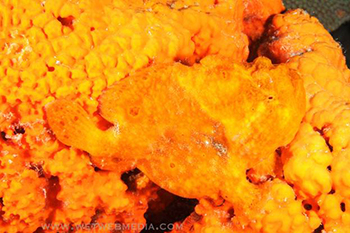
Domain: Eukaryota
Kingdom: Animalia
Phylum: Chordata
Subphylum: Vertebrata
Class: Actinopterygii
Subclass: Neopterygii
Order: Lophiiformes
Family: Antennariidae
Genus: Antennarius
Species: multiocellatus
The longlure frogfish is a member of the genus: Antennarius, and species: multiocellatus. The species multiocellatus was first described by Valendennes in 1837. Multiocellatus is Latin for “many eye-like spots.”
Range and habitat:
The longlure frogfish is confined to the tropical western part of the Atlantic Ocean from Bermuda and the Bahamas, south along the coasts of Central and South America, including Belize. It is a bottom dweller and prefers warm water and shallow reefs. It is normally found in areas populated by sponges.
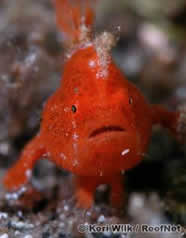 Anatomy:
Anatomy:
Frogfish have a large dark spot under the dorsal fin and can also have black spots on the body and fins. The longlure frogfish, which are short (@ 4.5 inches) and round, are often described as globular. Their thick skin is covered by dermal spicules which are spiky and look like warts. The longlure frogfish has small, laterally-directed eyes but a large mouth. The mouth is upturned and can expand to the width of the body to swallow prey. It has small gill openings which are situated behind the pectoral fins. The pectoral fins are modified and look like feet, including small toes. They are able to use the leg-like fins to walk across the bottom of the ocean floor.
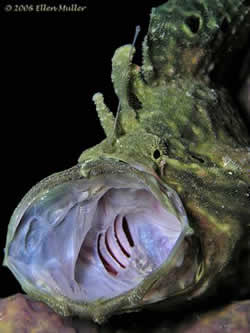
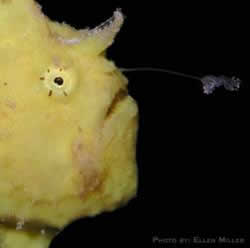
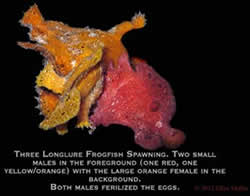
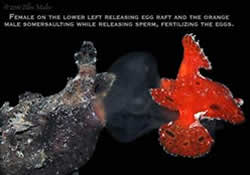
“Fishing”:
The longlure frogfish, or anglerfish, is named for its elongated illicium, the first spine of the dorsal fin, which has developed into a long rod with a lure or bait (esca) at the end that is used to attract prey. The longlure frogfish does not have a swim bladder, so it does not swim very often. It moves by sucking water in its mouth and expelling it through its gills. Because it can suck in a lot of water at one time and expel it forcefully, it is able to move quickly, skimming along just above the ground; however, most sit stock-still on sponges. Longlure frogfishes are able to change colors (from yellow to red or green to brown) to match nearby sponges or corals and their black spots mimic openings (ostia) of sponges.
Frogfish use aggressive resemblance to lure prey. Rather than using camouflage as a way to hide from predators, the frogfish uses its camouflage to confuse other animals into thinking it is coral or sponge, which they approach only to be ambushed. Each frogfish species moves the rod (illicium) with its lure (esca) in a special pattern to attract the attention of potential prey. While frog fish can amble across the bottom, the longlure frogfish generally lies in a sponge or on coral and waits for its prey to swim close to it. It then wiggles its lure. The frogfish can swallow fish, its main diet, that are larger in size than itself. It lowers it lower jaw and expands its upper jaw to expand the mouth, then it sucks the prey in by creating suction in the mouth, a maneuver called gape and suck. This maneuver is reported to take only 1/6th of a second.
Life Cycle:
The only way to differentiate between male and female frogfish is by examining the gonads by dissection. Frogfish are oviparous; their eggs develop and hatch outside the mother’s body. One of the unique features of the frogfish family is the use of the “egg raft” to transport eggs. The “egg raft” is a ribbon-like mass of gelatinous mucus which surrounds the eggs. The female fills up with over 40,000 eggs eight to ten hours before spawning. Frogfish are known to be cannibalistic, so spawning can be deadly. After that, the male and female frogfish “walk” across the bottom. The female, full of eggs, is often twice her normal size. The male is behind the female with his snout in contact with the female’s vent. Then they rise quickly to the surface and the “egg raft” is expelled from the female. The egg raft drifts for several days and can move for miles. After the embryos hatch, the raft sinks to the bottom. The embryos then enter the planktonic stage, which can last from one to two month. The small frogfish larva have large heads and a lure. Juvenile frogfish are smaller than adults, but look very much like them.
Importance to Humans:
The longlure frogfish is not a good aquarium fish because of its voracious appetite. They are interesting and colorful in the wild, but their camouflage is so good that they are hard to see. Because they are so hard to find, divers often get very close to coral with their bodies and cameras; however, there is no proof that coral damage is increased in frogfish habitats. The frogfish are not an endangered or threatened species.
Links:
Please note that the following links may have either been removed or relocated by the webpage owners since the time this student report was created.
www.flmnh.ufl.edu/fish/gallery/descript/frogfish/frogfish.htm
http://www.youtube.com/embed/DDwwTE-P-WU?rel=0
http://www.pbase.com/imagine/frogfishspawn
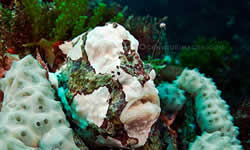 References:
References:
Please note that the following references may have either been removed or relocated by the webpage owners since the time this student report was created.
Antennarius multiocellatus at MarineBio.org. (2012). Marine Bio. Retrieved May 27,2012, from <http://marinebio.org/species.asp?id=28>.
Arnold, Rachel J., and Pietsch, Theodore W. (2011). Evolutionary history of frogfishes: A molecular approach. Molecular Phylogenetics & Evolution 62.1. doi:10.1016/j.ympev.2011.09.012
Fish, Frank E. (1987). Kinematics and power output of jet propulsion by the frogfish genus Antennarius (Lophiiformes: Antennariidae). Copeia. Retrieved May 28, 2012, from http://www.jstor.org/stable/1445573
Greenfield, David W., and Thomerson, Jamie E. (1977). Fishes of the continental waters of Belize. Gainesville: University Press of Florida, 1977.
Grobecker, David B., and Pietsch, Theodore, W. (1979). High-speed cinematographic evidence for ultrafast feeding in Antennariid anglerfishes. Science. Retrieved
May 25, 2012, from http://www.jstor.org/stable/1748067
Patton, Casey. (2011). Longlure frogfish. Ichthyology at the Florida Museum of Natural History. Retrieved May 27, 2012, from www.flmnh.ufl.edu/fish/gallery/descript/frogfish/frogfish.htm
Pietsch, Theodore W. (1984). The genera of frogfishes (Family Antennariidae). Copeia. 27-44. Retrieved May 26, 2012, from http://www.jstor.org/stable/1445032
Pietsch, Theodore W., and Grosbecker, David B. (1978). The complete angler: Aggressive mimicry in an Antennariid anglerfish. Science. Retrieved May 25,
2012, from http://www.jstor.org/stable/1746881
Uyarra, Maria C., and Côté, Isabelle M. (2007). The quest for cryptic creatures: Impacts of species-focused recreational diving on corals. Biological Conservation. Retrieved May 26, 2012, from (http://www.sciencedirect.com/science/article/pii/S0006320706005027)